
Search
The Renewable Energy site for Do-It-Yourselfers
Effect of Reducing Vent Size on
Thermosyphon Solar Air Heating Collector
|
This is a look at whether the inlet and outlet vent sizes can be
reduced in area on our
shop heating thermosyphon collector.
This question came from Paul House of
Choice Energy who has built several of these collectors on
Bozeman area buildings, and will fix you up with one for about $2000 --
probably the best payback commercial collector out there by a wide
margin.
Paul would like to be able to use a six inch hole saw to do the
vents. This would be faster and cleaner and improve the interior
appearance. Going from the current 4 by 18 inch rectangular vents
down to the 6 inch round vents would reduce the vent area by a bit more
than 50%, so the question is what is the effect on the collector
performance for these smaller vents?
Bottom line is that the smaller vents do quite well -- the flow rate
is down for the smaller vents, but the temperature rise is up enough to
compensate.
|
|
Testing the Smaller Vent Performance
Since my collector has 5 identical 4 ft wide bays, I set up the small vents
on one of the bays, and compared the temperature rise and air velocity of that
bay the adjacent unmodified bay. Heat output from the collector is
proportional to (airflow)*(temperature rise), so, a lower heat output will show
up as a drop in the product of these two numbers.
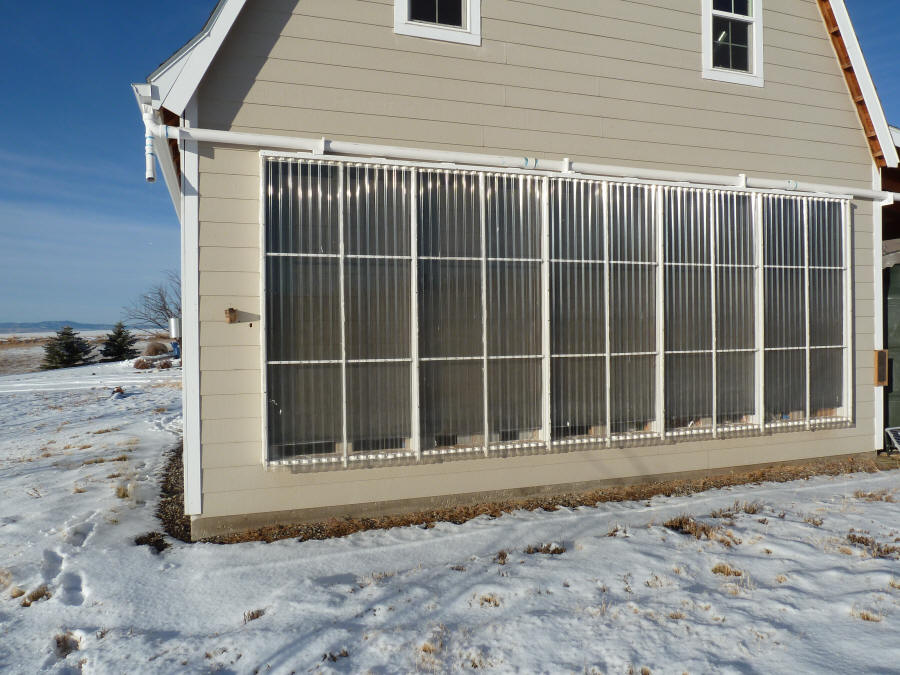
The collector from the outside.
This is the 8 ft high by 20 ft wide thermosyphon collector. Its a
very inexpensive yet quite efficient way to heat a large area. Because it
thermosyphons air through the collector, no fans and no controls are needed.
The only moving part is a simple poly film backflow preventer on each upper
vent.
About the only disadvantage of the collector is that it uses a large number
of fairly large vents. This is a bit of a hassle during the build, and the
large vents might get in the way a bit inside the space.
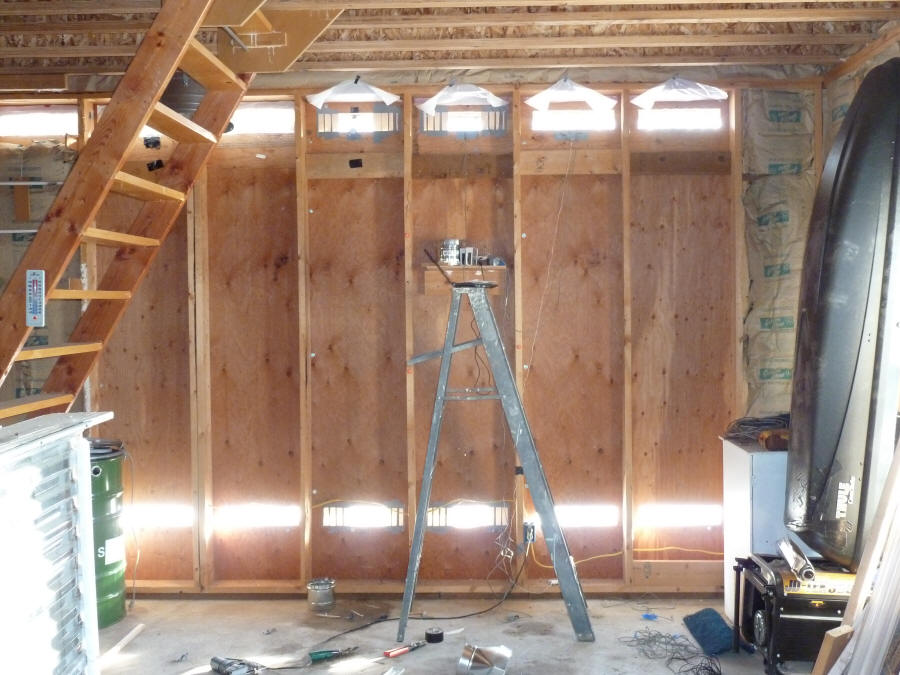
This shows most of the collector from the inside.
There is a 0.5 sqft (4 by 18 inch) vent every 2 ft across the top and across the
bottom.
Cutting Vent Size to 6 inch
Paul's idea is to use 6 inch diameter ducts to penetrate the wall for the
vents, and my first thought was to do exactly that by installing 6 inch ducts in
the center of each of the 4 vents in one 4 by 8 collector bay, but the
construction of my collector does not allow the center part of the vent to be
cut out to 6 inches.
So, I just masked in the existing 4 by 18 inch vents down to 4 inches high by
7.5 inches wide. This is 30 sq inches --just a bit more area than a 6 inch
round duct would give.
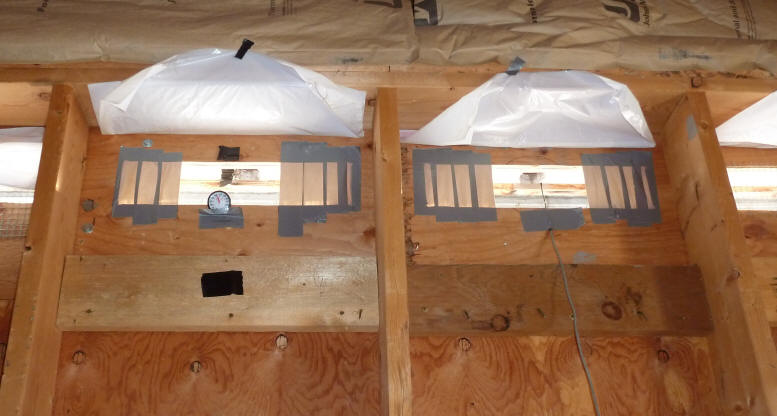
Upper vents masked down to 4 by 7.5 inches.
The duct tape looks almost transparent in this picture, but it is airtight and
well stuck together.
I measured the flow velocities with the Dwyer Vanemeter and a Kestrel wind
turbine meter.
The temperatures were measured using one thermistor for the two lower vents,
and a separate thermistor for each of the two upper vents. Temperatures
were logged on an Onset Computer U12 logger.
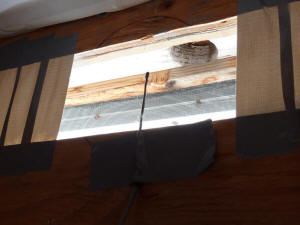
Fast acting thermistor measures air temperature. |
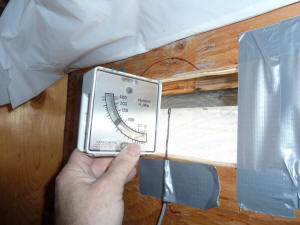
Dwyer Vanemeter to measure flow velocity.
A Kestrel wind turbine meter was also used. |
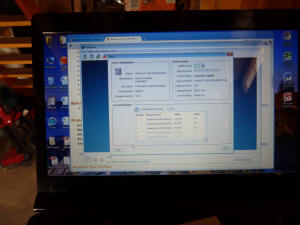
Logging the temperatures. |
I did not get to this until after 3 pm, and the building is pointed about 20
degrees east of south, so we are about 4 hours past peak sun on this nearly
shortest day of the year.
I'll try to remember to repeat this closer to midday just to make sure the
results hold up when the collector is cooking harder.

The log of vent temperatures.
The inlet vents are picking up air near the floor at about 57F.
The 6 inch vent exit temp is 102.4F
The 4 by 18 vent exit temp is 86.5 F
| Vent configuration |
Flow Velocity (fpm) |
Flow Rate (cfm) |
Inlet temp (F) |
Outlet Temp (F) |
Temp Rise (F) |
Heat output per bay
(BTU/hr) |
Change in Heat Output |
| 4 by 18 vent |
70 |
70 cfm per pay |
56.1 |
86.5 |
30.4 |
2154 |
Base |
| 4 by 7.5 vent (sim 6 inch
round) |
113 |
47.4 cfm/bay |
56.1 |
102.4 |
46.3 |
2202 |
About the same |
| |
|
|
|
|
|
|
|
So, within the experimental error, there appears to be no drop in heat output
for going down to the smaller vents. The flow rate drops significantly for
the smaller vents, but the temperature rise goes up by enough to make the heat
output the same. That is, the air is flowing through the collector more
slowly which lowers heat output, but it has more time in the collector to warm
up more, which raises heat output. Normally you would expect some drop in
efficiency as the temperature rise through the collector increases because the
collector internals are running hotter and lose more heat out the glazing, but
this is apparently not that significant in this case.
Gary
December 20, 2011

